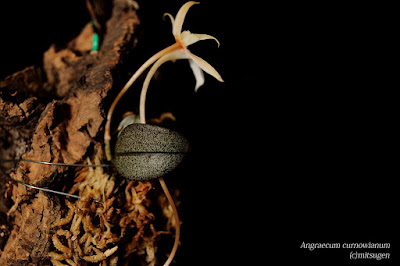Aerangis curnowiana is native to Madagascar. This orchid can be found in the central-eastern part of the island, near Antananarivo. It grows as an epiphyte in moist forests at heights of 1000-1200 m.
Aerangis curnowiana orchid, also called as Curnow's Aerangis (named after the English cultivator of species Curnow), Rhaphidorhynchus curnowianus, is a species of the genus Aerangis. This species was described by (Finet) H. Perrier in 1938.
IDENTIFY AERANGIS CURNOWIANA ORCHID
Aerangis curnowiana is native to Madagascar. This orchid can be found in the central-eastern part of the island, near Antananarivo. It grows as an epiphyte in moist forests at heights of 1000-1200 m.
It is a miniature sized, hot to warm growing epiphyte with almost no stem. The leaves are 3-4 cm long and 1.2-2.2 cm wide. Skeletal leaves are often shiny, slightly brownish and sometimes covered with small gray spots, and their edges are usually brown. The roots of this species are distinct because they are flattened, grey, finely warty, and have amber to copper colored root tips.
Curnow's Aerangis blooms in the mid summer to fall on an axillary, 2 3/4" to 3 1/4" (7 to 8 cm) long, 1 to 2 flowered inflorescence giving rise to flowers that have a spur that in bud forms a perfect circle but as the flower opens it straightens out to a half curve and eventually appears to be "S" shaped and is 4 to 5 1/4" (10 to 13 cm) long. The flakes of both whorls often have a brownish color and the lip is white. Triangular, sharp tip is longer and wider than the other parts of the flower, and its edges wriggle up giving it the appearance of a boat.
AERANGIS CURNOWIANA CARE AND CULTURE
Cultural information should only be used as a guide, and should be to be adapted to suit you. Your physical location; where you grow your plants, how much time you have to devote to their care, and many other factors, will need to be taken into account. Only then can you decide on the cultural methods that best suit you and your plants.
Light:
Aerangis curnowiana needs a light level of 12000-18000 lux. This plant require shady positions and initiate flower shoots even grown at very low light levels. They should be protected from the direct sun. Strong air movement should be ensured all the time.
Temperature:
Curnow's Aerangis is a plant with warm/moderate thermal requirements. In summer the average day temperature is 28-29 ° C, night 18 ° C, which gives a daily difference of 9-11 ° C. The average winter temperature is 22-23 ° C during the day and 11-12 ° C at night, giving a diurnal difference of 11-12 ° C.
Humidity:
This species needs a humidity level of about 75-80% for most of the year. For 4 months of late winter and spring the humidity drops to about 65-70%.
Substrate, growing media and repotting:
Aerangis curnowiana grow best when fixed on cork pieces with a certain amount of sphagnum moss placed under the plant. If you use pots, use a very loose substrate to allow access to the roots and a quick drying between watering. Baskets or small clay pots give better results than plastic pots.
Repotting should be carried out when new roots start growing, which allows the plant to settle in the new container as quickly as possible.
Watering:
Aerangis curnowiana should be watered strongly during the period of active growth (from late spring to autumn), but the roots must always dry quickly after watering.
Fertilizer:
Plants should be fertilized every week 1/4-1/2 of the recommended dose of fertilizer for orchids. A fertilizer with a high nitrogen content is beneficial from spring to mid-summer, and a fertilizer richer in phosphorus should be used in late summer and autumn.
Rest period:
Aerangis curnowiana require less water throughout the winter, but they should be watered regularly to prevent excessive drying. In general, occasional fogging in the early morning between rare watering is sufficient. However, the amount of water supplied should be increased if the leaves wrinkle or show signs of weakness.

















COMMENTS